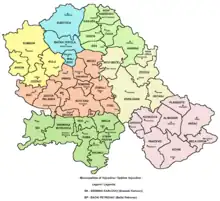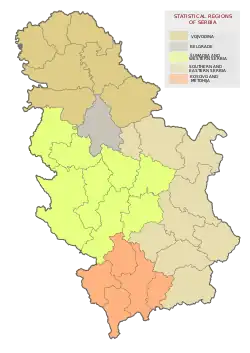Lajkovac
| |
|---|---|
Town and municipality | |
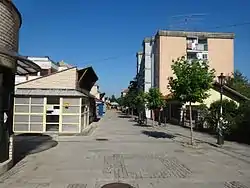 Town center promenade | |
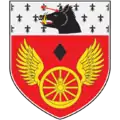 Coat of arms | |
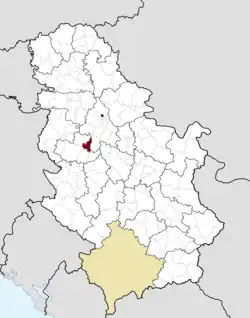 Location of the municipality of Lajkovac within Serbia | |
| Coordinates: 44°22′N 20°10′E / 44.367°N 20.167°E | |
| Country | |
| Region | Šumadija and Western Serbia |
| District | Kolubara |
| Settlements | 19 |
| Government | |
| • Mayor | Andrija Živković (SNS) |
| Area | |
| • Town | 2.23 km2 (0.86 sq mi) |
| • Municipality | 186 km2 (72 sq mi) |
| Elevation | 113 m (371 ft) |
| Population (2011 census)[2] | |
| • Town | 3,249 |
| • Town density | 1,500/km2 (3,800/sq mi) |
| • Municipality | 15,475 |
| • Municipality density | 83/km2 (220/sq mi) |
| Time zone | UTC+1 (CET) |
| • Summer (DST) | UTC+2 (CEST) |
| Postal code | 14224 |
| Area code | +381(0)14 |
| Car plates | VA |
| Website | www |
Lajkovac (Serbian Cyrillic: Лајковац) is a town and municipality located in the Kolubara District of western Serbia. As of 2011, it has population of 3,249 inhabitants, while the municipality has 15,475 inhabitants.
It is located in the valley of river Kolubara and near the Ibar highway.
History
In the surrounding villages of Jabučje, Skobalj, Nepričava and Bogovađa there are remains from the Roman period. At Ćelije there is an archaeological locality Anine, also from the Roman times, with the well preserved Roman villa and a major estate around it. Anine is located 1 km (0.62 mi) from the confluence of the Ljig river into the Kolubara. There are also artifacts and monuments from the Serbian medieval period, First Serbian Uprising, Second Serbian Uprising and both World Wars, especially World War I as the major Battle of Kolubara against the invading Austro-Hungarian army was fought in the area in November-December 1914.[3]
The town was heavily flooded by the Kolubara river. In July 1926 the water destroyed the entire agricultural output, also flooding the railway. The area was also damaged during the catastrophic 2014 Southeast Europe floods.[3]
Settlements
Aside from the town of Lajkovac, the following settlements are comprised in the municipality of Lajkovac:
Demographics
| Year | Pop. | ±% p.a. |
|---|---|---|
| 1948 | 17,587 | — |
| 1953 | 18,411 | +0.92% |
| 1961 | 18,985 | +0.38% |
| 1971 | 18,270 | −0.38% |
| 1981 | 17,950 | −0.18% |
| 1991 | 17,716 | −0.13% |
| 2002 | 17,062 | −0.34% |
| 2011 | 15,475 | −1.08% |
| Source: [4] | ||
According to the 2011 census results, the municipality of Lajkovac has 15,475 inhabitants.
Ethnic groups
The ethnic composition of the municipality:[5]
| Ethnic group | Population | % |
|---|---|---|
| Serbs | 14,381 | 92.93% |
| Roma | 775 | 5.01% |
| Montenegrins | 22 | 0.14% |
| Yugoslavs | 16 | 0.10% |
| Macedonians | 13 | 0.08% |
| Croats | 11 | 0.07% |
| Others | 257 | 1.66% |
| Total | 15,475 |
Economy and infrastructure
Unlike the past, when the railway was the leading employer in the area, most of Lajkovac inhabitants today work at surface pits of the Kolubara coal basin, that stretch on the municipal areas of Lajkovac, Lazarevac and Ub. Other major industries include agriculture (especially dairy and fruit production), electricity wiring metal constructions and textile manufacturing.
Thanks to the surface mining, Lajkovac is usually among the municipalities with the highest average wage and employment figures in Serbia.
Tourist spots in the town and its vicinity include the Bogovađa Monastery and the memorial Saint George's Church in the village of Ćelije.[3]
Lajkovac was well known for its watermills (Serbian: vodenica). There are several still operational in 2018 though they are mostly a tourist attractions today. The most popular are Jolića vodenica, Kumova vodenica, Ilića vodenica and Sretenovića vodenica. Jolića vodenica is location of an annual folk festival Hajdučki rastanak.[3]
The following table gives a preview of total number of employed people per their core activity (as of 2017):[6]
| Activity | Total |
|---|---|
| Agriculture, forestry and fishing | 29 |
| Mining | 1,313 |
| Processing industry | 543 |
| Distribution of power, gas and water | - |
| Distribution of water and water waste management | 84 |
| Construction | 164 |
| Wholesale and retail, repair | 293 |
| Traffic, storage and communication | 112 |
| Hotels and restaurants | 65 |
| Media and telecommunications | 15 |
| Finance and insurance | 18 |
| Property stock and charter | 4 |
| Professional, scientific, innovative and technical activities | 50 |
| Administrative and other services | 20 |
| Administration and social assurance | 144 |
| Education | 285 |
| Healthcare and social work | 112 |
| Art, leisure and recreation | 54 |
| Other services | 39 |
| Total | 3,344 |
Railway significance
The first railway line to pass through Lajkovac was a 760-millimeter (Bosnian gauge) line from Obrenovac to Valjevo which became operational on 14 September 1908.[3] Two years later, Lajkovac got another line to Mladenovac. Just before the outbreak of World War I, the Serbian government started construction of line to Čačak, but the early war operations halted the development. In 1914, Dual Monarchy army stormed the city and destroyed much of the infrastructure; shortly afterwards, however the same force continued construction of a line to Čačak. After the end of the war in 1921, Čačak line was completed, connecting Lajkovac with Sarajevo and the Adriatic seaports of Dubrovnik and Herceg Novi. In 1928, the Obrenovac line was extended to Belgrade, which promoted the town into a railway hub of major importance.
The lots around the railway were quickly urbanized and mostly turned into the kafanas. In the late 1930s there were 11 kafanas in Lajkovac, as people had to make connections in Lajkovac since it was a crossroad from all four sides (Belgrade, Aranđelovac, Mladenovac, Sarajevo). Especially popular was the Železnička restoracija ("Railway restaurant"), which is still operation as of March 2018. Among notable frequent guests were politician Mehmed Spaho and mathematician Mika Petrović Alas. The town prospered greatly becoming a major railway crossroads and this period is today considered as the Lajkovac's "Golden Age". There were 41 railway tracks in town itself, with one train arriving every 10 minutes. At one point, there were 1,500 railwaymen working on a railroad.[3] The first train using the standard gauge reached Lajkovac on 7 July 1968.[7] The decline of the Yugoslav Railways narrow-gauge network in 1960s led to a decision that all narrow-gauge lines should cease operation during the 1970s. At the same time, the Belgrade-Bar standard gauge line passed through Lajkovac.
Much of the narrow-gauge infrastructure remains in the town today, such as a water tower (nicknamed Buzometar), turntable, roundhouse and many rolling stock sheds.[3] All that infrastructure except for the water tower still serves standard-gauge locomotive stock. There are plans to convert these facilities into a railway museum.
Trivia
The traditional song Ide Mile Lajkovačkom prugom (Mile walks down the Lajkovac railway) is about the town; it is a staple of Serbian folk repertoire, with versions recorded by Tozovac, Lepa Lukić, Šaban Šaulić, Braća Bajić and many others.
Gallery
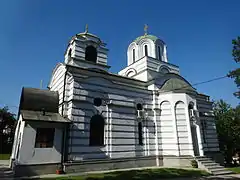 Orthodox Church in Lajkovac
Orthodox Church in Lajkovac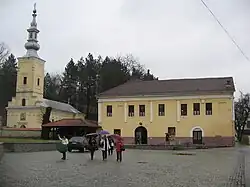 Monastery Bogovađa
Monastery Bogovađa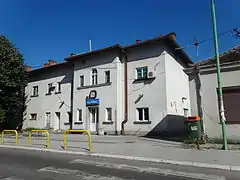 Lajkovac Railway Station building
Lajkovac Railway Station building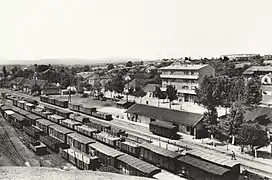 Lajkovac Railway Station in 1965
Lajkovac Railway Station in 1965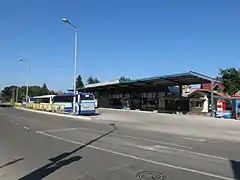 Lajkovac Bus Station
Lajkovac Bus Station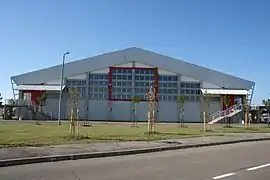 Lajkovac Sports Hall
Lajkovac Sports Hall
References
- ↑ "Municipalities of Serbia, 2006". Statistical Office of Serbia. Retrieved 2010-11-28.
- ↑ "2011 Census of Population, Households and Dwellings in the Republic of Serbia: Comparative Overview of the Number of Population in 1948, 1953, 1961, 1971, 1981, 1991, 2002 and 2011, Data by settlements" (PDF). Statistical Office of Republic Of Serbia, Belgrade. 2014. ISBN 978-86-6161-109-4. Retrieved 2014-06-27.
- 1 2 3 4 5 6 7 Miroslav Stefanović (25 March 2018). "Železničari simbol varoši" [Railwaymen, symbol of a small town]. Politika-Magazin, No. 1069 (in Serbian). pp. 19–21.
- ↑ "2011 Census of Population, Households and Dwellings in the Republic of Serbia" (PDF). stat.gov.rs. Statistical Office of the Republic of Serbia. Retrieved 18 August 2017.
- ↑ "Population by ethnicity and sex, by municipalities and cities" (PDF). stat.gov.rs. Statistical Office of Serbia. Retrieved 18 August 2017.
- ↑ "ОПШТИНЕ И РЕГИОНИ У РЕПУБЛИЦИ СРБИЈИ, 2018" (PDF). stat.gov.rs (in Serbian). Statistical Office of the Republic of Serbia. Retrieved 16 March 2019.
- ↑ V.Đuđrević (8 July 1968). "У Лајковац стигао први воз нормалног колосека" [First train reached Lajkovac via a standard gauge]. Politika (in Serbian).
